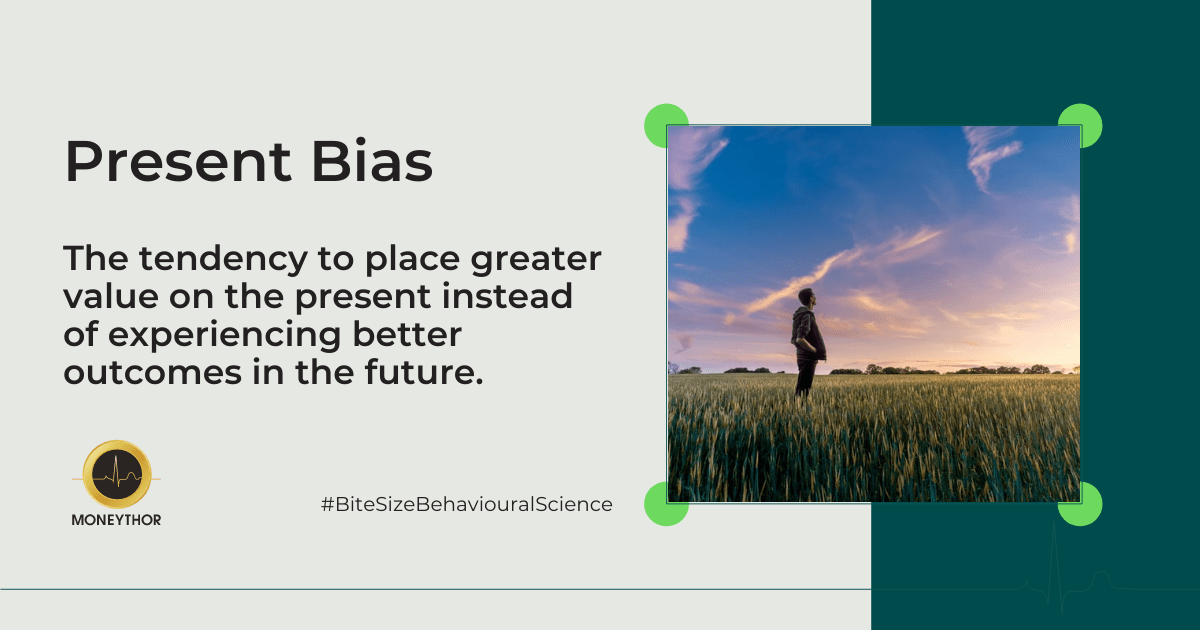As technology and social media make our interactions so instant, it can become hard to delay gratification in other areas of our life. Perhaps you have a load of laundry to do that you have put off doing for several days, but you decide to watch a movie with some friends instead? Are you delaying working on a project, but find yourself scrolling and posting on Instagram? We are often distracted from achieving our long-term goals as we enjoy the immediate benefits from making shorter-term decisions. These distractions from long term progress can prevent us reaching our goals, including financial ones, living aspirationally and becoming the versions of ourselves we hope to be.
What is Present Bias?
Staying the course on long term commitments that are beneficial for the future sometimes seems like the biggest challenge. What we want now can be the opposite of what we aspire to in the future. Present bias occurs when a greater value is placed on achieving something in the present moment, rather than experiencing better outcomes in the future.
When deciding what to spend money on or how to allocate time to different activities, the present bias suggests that we often end up making short term decisions that prevents us from becoming the best and most ideal versions of ourselves. As aspirational as we might be, we are also time-inconsistent and often behave more impulsively the sooner our decisions take effect; behaviour our future-self may regret.
How can financial institutions and banks help customers navigate and avoid present bias?
Encourage “future lock-ins”
A great way to discourage present bias for your consumers is to employ “future lock-ins”. Consumers know and believe that they should make certain choices, but don’t always want to act on them immediately. By making them commit to something in the future, they are more likely to choose an option that will benefit their future financial wellbeing. Committing to a future action like paying into a pension plan at a regular, self-appointed, and specific time (e.g., when a customer gets paid) will increase the likelihood of prospective self-control and prevent customers from getting distracted and ultimately achieving their savings goals in a timely manner.
Building around your customers’ goals
Understanding your customers’ needs is the first step to building around their goals. With the Moneythor solution, presenting quizzes and questionnaires to your consumers can help them ascertain their needs and preferences. This helps banks develop a better understanding of what the customer needs whilst also dictating what savings products or features are shown to them, along with the occasional nudge or reminder to keep them on track and committed to their goals.
Keep customers invested in the journey by reframing rewards
For the customers that are unable to overcome present bias, find alternative ways to make it work for them. PFM solutions can help users stay invested in their savings journey by setting up goals that highlight the smaller milestone achievements along the way. When it comes to accomplishing goals, the process matters as much as the outcomes as it can often be an accurate predictor of success. Highlighting such milestone achievements will provide the timely reminders necessary to keep customers focused on the long-term outcomes they desire.
Conclusion
It is important for financial institutions to acknowledge and understand the present bias in consumers’ decision making. For some consumers, future lock ins can be an effective methodology to re-shift focus back to the long-term goals, whereas for others, the natural preference to make decisions based on short-term payoffs can be managed by introducing intermediate milestones. Banks want customers to enjoy the immediate benefits of their financial decisions, whilst not detracting from their long-term goals. Helping consumers better understand their own needs and goals is a vital starting point for banks to manage their engagement over the short and long term, while also bolstering their customers’ financial wellbeing.

